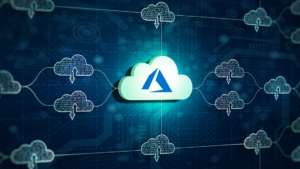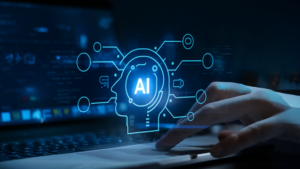

ACL Digital
5 Minutes read
Beyond Migration: How AI-powered FinOps and Edge Computing Are Redefining Cloud Transformation in 2025
The cloud revolution has hit a whole new frontier. Basically, for the better part of the past two decades, businesses focused largely on cloud migration services—taking workloads from on-premises data centers into public, private, or hybrid-cloud architecture platforms. The first wave-built scale, resilience, and pay-per-use flexibility; in 2025, however, conversations are moving toward a further level of refinement: realizing value. Organizations are now incorporating cloud ecosystems with AI-Powered FinOps, and edge computing, all working toward measurable business outcomes.
That is to say, the “lift and-shift” paradigm has evolved; the measure of success of cloud projects ceased to revolve around migration milestones and started focusing on efficiency, governance, and innovation post-migration. Let’s see how the cloud transformation strategy is evolving, the trends shaping cloud modernization in 2025, and why organizations need to begin preparing for a new AI-driven FinOps and edge-powered reality.
From Migration to Transformation: The Strategic Shift
In 2025, the focus has shifted toward cloud modernization trends where organizations are asking:
- How do we optimize workloads in multi-vendor ecosystems?
- How are we handling AI workloads in cloud environments so that we don’t go out of budget?
- How can we secure multi-cloud management frameworks for compliance, performance, and governance?
The answer lies in integrating FinOps cloud optimization practices with intelligent cloud operations, augmented by edge and AI-driven analytics.
AI-Powered FinOps: The New Cloud Governance Engine
As workloads scale, organizations struggle with unpredictability of costs, shadow IT, and resources misuse. Enter FinOps cloud optimization, a doctrine that unites financial accountability with engineering efficiency. But in 2025, FinOps is far from spreadsheets and manual interventions. AI is now the very heart of cloud cost governance.
Modern FinOps platforms use machine learning to:
- Forecast workload demand for AI workloads in cloud, and auto-scale resources accordingly.
- Provide intelligent recommendations for hybrid cloud architecture deployments for placing resources optimally.
- Enforce real-time alerting and safeguards around spend thresholds, so cloud cost governance is a never-ending process.
- Fine tune pricing model setups across various providers using an adaptive multi-cloud management solution.
With AI at its core, FinOps finds its transformation in being a reactive discipline into a full predictive and automated system-enhancing every cloud transformation strategy.
Intelligent Cloud Operations: From Monitoring to Autonomy
Traditional cloud operations have been those focused on dashboards, monitoring, and reactive troubleshooting. That is, until they got interrupted by billions of metrics streaming from containers, VMs, and AI workloads in the cloud, vastly multiplying the study.
Now comes the year 2025, when intelligent cloud operations become console. With AI-powered observability aided by cloud operations:
- Anomaly detection in real-time across hybrid cloud architectures.
- Automated remediation to events downing a system or creating severe latency.
- Ensures compliance and cloud cost governance 24/7, uninterrupted by human interference.
- Workload balancing between servers, regions, and even providers dynamically within multi-cloud management contexts.
Edge Computing in Cloud: The Decentralization Movement
By providing the backbone to centralized cloud infrastructure, 2025 also sees edge computing in cloud ecosystems baking a new paradigm. The multiplied presence of IoTian edge: liances of interviews, 5G networks, and real-time analytics require computation near the data source.
Edge computing in cloud lends support on:
- Keep latency low for mission-critical applications, such as autonomous vehicles, healthcare diagnostics, and industrial automation.
- Preserves network bandwidth by processing data locally before it syncs up with the central clouds.
- Offers some resilience by empowering through the smaller dependency on a single data center.
Organizations using hybrid cloud architecture blend edge clusters and central cloud workloads, positioning them optimally for the best of the central and edge clouds.
Multi-Cloud Management and Governance Challenges
About 90 percent of organizations work on different cloud providers in 2025. Not strictly on cost arbitrage but compliance, performance parity, and resilience requirements. That’s what makes multi-cloud management no longer an option—must.
At the same time, AWS-Azure-GCP-private hybrid cloud workload balancing entails a whole set of challenges:
- Visibility into costs often becomes fragmented.
- AI optimizations need to be consistent across diverse platforms.
- Multi-provider SLAs and compliance requirements must stay intact.
Here, AI-powered cloud cost governance coupled with FinOps cloud optimization guarantee that businesses never lose sight of their financial and operational controls. Unified dashboards, predictive insights, and automated control are now the foundational backdrop to any modern cloud transformation strategizing.
Cloud Modernization Trends 2025: What’s Next?
The year of 2025 has already seen a few game-changing cloud modernization trends that extend beyond migration:
- Autonomous Cloud FinOps – Platforms recommend scaling, rightsizing, and switching providers; such platforms execute the scaling and rightsizing and switching.
- Decentralized Cloud Via Edge – The rise of edge computing at the cloud level for latency-sensitive applications will only pick up speed.
- Industry-specific AI Workloads – Retail, banking, and healthcare are designing a bespoke AI workload in the cloud and need domain-aware optimization.
- Sustainable Cloud Operations – Intelligent FinOps tools measure carbon impact as part of cloud cost governance, striving to reach ESG objectives.
- Security-First Multi-cloud – Multi-cloud frameworks embed zero-trust and AI-driven compliance validation, rewriting security standards.
The above-listed things illustrate cloud modernization of 2025 to be less of technology adoption and more of a realization of AI, finance, compliance, and edge-driven decentralization into an acknowledgment of cloud transformation.
Why Organizations Must Evolve Beyond Migration
Migration is merely a starting line. Organizations that stop their risk spiraling costs, inefficiencies, and inability to scale their digital ambitions. By embedding FinOps cloud optimization and intelligent cloud operations into their cloud transformation strategy, businesses position themselves to thrive in a future where agility, governance, and edge integration define competitiveness.
Conclusion
In 2025, cloud is no longer about where your applications live—it’s about how intelligently they run, how efficiently they’re governed, and how seamlessly they extend to the edge. The convergence of FinOps cloud optimization, intelligent cloud operations, and edge computing in cloud is fundamentally reshaping the narrative of cloud maturity.
The future of cloud modernization trends lies beyond migration. Organizations with forward-looking cloud transformation strategies, grounded in cloud cost governance, AI-driven insights, and effective multi-cloud management, will not just survive but thrive in the next wave of the digital economy.
Ready to move beyond migration? Explore how ACL Digital’s cloud experts can help you design a smarter cloud transformation strategy. Talk to us.
Sources
- https://cloudverse.ai/blog/future-trends-in-cloud-computing
- https://www.cionet.com/news/unpacking-the-10-top-cloud-computing-trends-for-2025-and-beyond
- https://elnion.com/2025/08/13/navigating-the-data-warehouse-revolution-how-cloud-innovation-is-redefining-enterprise-intelligence-in-2025/
- https://amnic.com/blogs/cloud-leaders-emerging-trends-growth-insights
Related Insights


Death to Prompting! Long Live Programming!

The AI Developer’s Guide to Data Formats: TOON vs. JSON and Beyond


Matter Protocol: Powering the Smart Infrastructure of Future Cities

